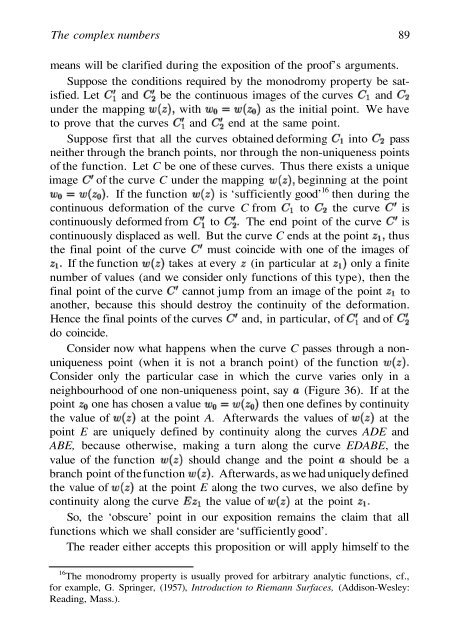Abel's theorem in problems and solutions - School of Mathematics
Abel's theorem in problems and solutions - School of Mathematics
Abel's theorem in problems and solutions - School of Mathematics
Create successful ePaper yourself
Turn your PDF publications into a flip-book with our unique Google optimized e-Paper software.
The complex numbers 89<br />
means will be clarified dur<strong>in</strong>g the exposition <strong>of</strong> the pro<strong>of</strong>’s arguments.<br />
Suppose the conditions required by the monodromy property be satisfied.<br />
Let <strong>and</strong> be the cont<strong>in</strong>uous images <strong>of</strong> the curves <strong>and</strong><br />
under the mapp<strong>in</strong>g with as the <strong>in</strong>itial po<strong>in</strong>t. We have<br />
to prove that the curves <strong>and</strong> end at the same po<strong>in</strong>t.<br />
Suppose first that all the curves obta<strong>in</strong>ed deform<strong>in</strong>g <strong>in</strong>to pass<br />
neither through the branch po<strong>in</strong>ts, nor through the non-uniqueness po<strong>in</strong>ts<br />
<strong>of</strong> the function. Let C be one <strong>of</strong> these curves. Thus there exists a unique<br />
image <strong>of</strong> the curve C under the mapp<strong>in</strong>g beg<strong>in</strong>n<strong>in</strong>g at the po<strong>in</strong>t<br />
If the function is ‘sufficiently good’ 16 then dur<strong>in</strong>g the<br />
cont<strong>in</strong>uous deformation <strong>of</strong> the curve C from to the curve is<br />
cont<strong>in</strong>uously deformed from to The end po<strong>in</strong>t <strong>of</strong> the curve is<br />
cont<strong>in</strong>uously displaced as well. But the curve C ends at the po<strong>in</strong>t thus<br />
the f<strong>in</strong>al po<strong>in</strong>t <strong>of</strong> the curve must co<strong>in</strong>cide with one <strong>of</strong> the images <strong>of</strong><br />
If the function takes at every (<strong>in</strong> particular at only a f<strong>in</strong>ite<br />
number <strong>of</strong> values (<strong>and</strong> we consider only functions <strong>of</strong> this type), then the<br />
f<strong>in</strong>al po<strong>in</strong>t <strong>of</strong> the curve cannot jump from an image <strong>of</strong> the po<strong>in</strong>t to<br />
another, because this should destroy the cont<strong>in</strong>uity <strong>of</strong> the deformation.<br />
Hence the f<strong>in</strong>al po<strong>in</strong>ts <strong>of</strong> the curves <strong>and</strong>, <strong>in</strong> particular, <strong>of</strong> <strong>and</strong> <strong>of</strong><br />
do co<strong>in</strong>cide.<br />
Consider now what happens when the curve C passes through a nonuniqueness<br />
po<strong>in</strong>t (when it is not a branch po<strong>in</strong>t) <strong>of</strong> the function<br />
Consider only the particular case <strong>in</strong> which the curve varies only <strong>in</strong> a<br />
neighbourhood <strong>of</strong> one non-uniqueness po<strong>in</strong>t, say (Figure 36). If at the<br />
po<strong>in</strong>t one has chosen a value then one def<strong>in</strong>es by cont<strong>in</strong>uity<br />
the value <strong>of</strong> at the po<strong>in</strong>t A. Afterwards the values <strong>of</strong> at the<br />
po<strong>in</strong>t E are uniquely def<strong>in</strong>ed by cont<strong>in</strong>uity along the curves ADE <strong>and</strong><br />
ABE, because otherwise, mak<strong>in</strong>g a turn along the curve EDABE, the<br />
value <strong>of</strong> the function should change <strong>and</strong> the po<strong>in</strong>t should be a<br />
branch po<strong>in</strong>t <strong>of</strong> the function Afterwards, as we had uniquely def<strong>in</strong>ed<br />
the value <strong>of</strong> at the po<strong>in</strong>t E along the two curves, we also def<strong>in</strong>e by<br />
cont<strong>in</strong>uity along the curve the value <strong>of</strong> at the po<strong>in</strong>t<br />
So, the ‘obscure’ po<strong>in</strong>t <strong>in</strong> our exposition rema<strong>in</strong>s the claim that all<br />
functions which we shall consider are ‘sufficiently good’.<br />
The reader either accepts this proposition or will apply himself to the<br />
16 The monodromy property is usually proved for arbitrary analytic functions, cf.,<br />
for example, G. Spr<strong>in</strong>ger, (1957), Introduction to Riemann Surfaces, (Addison-Wesley:<br />
Read<strong>in</strong>g, Mass.).

















